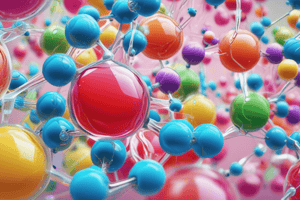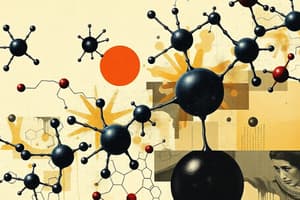Podcast
Questions and Answers
What type of reaction is dehydration synthesis?
What type of reaction is dehydration synthesis?
- A reaction that removes water to form polymers (correct)
- A reaction that breaks down lipids
- A reaction that converts carbohydrates to proteins
- A reaction that adds water to break polymers
Hydrolysis is the process of forming polymers by adding water.
Hydrolysis is the process of forming polymers by adding water.
False (B)
What are the monomers of carbohydrates?
What are the monomers of carbohydrates?
Monosaccharides
The ratio of carbon, hydrogen, and oxygen in carbohydrates is ::___.
The ratio of carbon, hydrogen, and oxygen in carbohydrates is ::___.
Match the following organic molecules with their functions:
Match the following organic molecules with their functions:
Which of the following is NOT an example of a lipid?
Which of the following is NOT an example of a lipid?
Proteins can consist of a chain of fewer than 20 different amino acids.
Proteins can consist of a chain of fewer than 20 different amino acids.
What is denaturation in regards to proteins?
What is denaturation in regards to proteins?
Which of the following components is NOT part of a nucleotide?
Which of the following components is NOT part of a nucleotide?
RNA contains thymine (T) as one of its nitrogen bases.
RNA contains thymine (T) as one of its nitrogen bases.
What is the primary function of DNA in cells?
What is the primary function of DNA in cells?
The twisted ladder shape of DNA is known as a __________.
The twisted ladder shape of DNA is known as a __________.
Match the following enzymes-related terms with their definitions:
Match the following enzymes-related terms with their definitions:
Which of the following statements about enzymes is true?
Which of the following statements about enzymes is true?
DNA and RNA are both types of proteins.
DNA and RNA are both types of proteins.
What happens to an enzyme when it undergoes denaturation?
What happens to an enzyme when it undergoes denaturation?
Flashcards
Nucleotide
Nucleotide
A molecule made of three parts: a sugar, a phosphate, and a nitrogen base.
Polynucleotide
Polynucleotide
A nucleic acid is a polymer made of many nucleotides.
DNA
DNA
DNA stands for Deoxyribonucleic acid. It contains the genetic instructions for making proteins.
RNA
RNA
Signup and view all the flashcards
Enzyme
Enzyme
Signup and view all the flashcards
Active site
Active site
Signup and view all the flashcards
Substrate
Substrate
Signup and view all the flashcards
Denaturation
Denaturation
Signup and view all the flashcards
Hydrolysis
Hydrolysis
Signup and view all the flashcards
Dehydration synthesis
Dehydration synthesis
Signup and view all the flashcards
Monomer
Monomer
Signup and view all the flashcards
Polymer
Polymer
Signup and view all the flashcards
Carbohydrate
Carbohydrate
Signup and view all the flashcards
Lipid
Lipid
Signup and view all the flashcards
Protein
Protein
Signup and view all the flashcards
Study Notes
Organic Compounds
- Organic compounds contain carbon, hydrogen, and often oxygen.
- Monomers are small molecules; polymers are large molecules made of monomers joined by covalent bonds.
- Dehydration synthesis creates polymers by removing water; hydrolysis breaks polymers into monomers by adding water.
Four Groups of Organic Molecules
- Carbohydrates: Elements C, H, O in a 1:2:1 ratio. Monomers are monosaccharides (simple sugars) like glucose. Examples include starch, cellulose, and glycogen. Functions include short-term energy storage.
- Lipids: Elements C, H, O, not in a 1:2:1 ratio; very little oxygen. Monomers are fatty acids. Polymers are triglycerides. Examples include fats, oils, waxes, steroids, and phospholipids. Functions include long-term energy storage and forming cell membranes.
- Proteins: Elements C, H, O, N (sometimes P & S). Monomers are amino acids (20 different types). Functions include structural support, enzymes (catalysts), and other bodily functions.
- Nucleic Acids: Elements C, H, O, N, P. Monomers are nucleotides (sugar, phosphate, and a nitrogenous base). Polymers are DNA and RNA. Examples are DNA and RNA. Functions include storing and transmitting genetic information.
Polymers Details
- Proteins: Polypeptides (amino acid chains) with primary, secondary, tertiary, and sometimes quaternary structures. Shape determines function. Denaturation changes shape with high temperature or pH.
- Nucleic Acids: Polynucleotides (nucleotides chains). DNA is a double helix with A-T and G-C base pairings, while RNA is a single strand with A-U, G-C pairings. DNA stores genetic information; RNA helps synthesize proteins.
Enzymes
- Enzymes are proteins that catalyze (speed up) biochemical reactions without being consumed.
- Enzymes are reusable.
- Active site: location where the substrate binds.
- Substrate: substance the enzyme acts upon.
- Shape & specificity: An enzyme is specific to its substrate and denatures with significant pH or temperature changes.
Studying That Suits You
Use AI to generate personalized quizzes and flashcards to suit your learning preferences.




